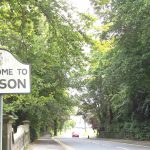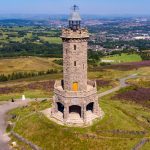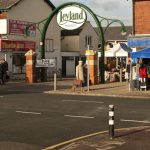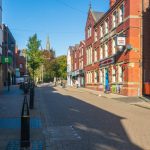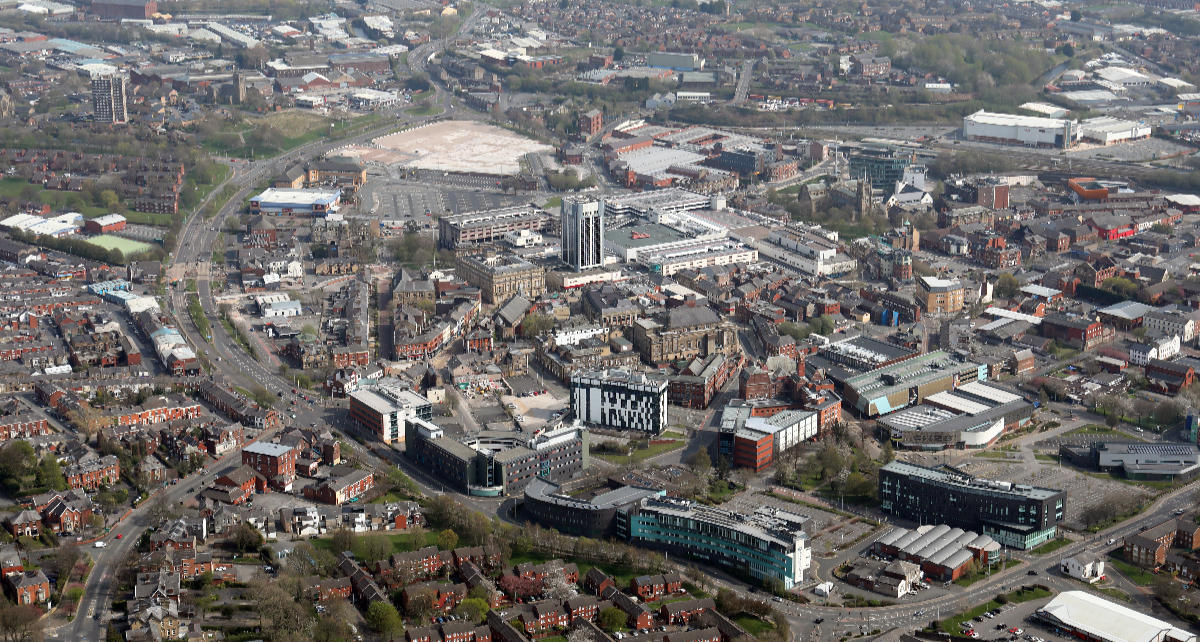
Mention the name Blackburn to a non-UK resident and you will probably get a blank look and we wager that a few people based south of Watford would have difficulty pointing it out on the map. This is a shame as this fine Lancashire town is steeped in history, has a famous football club (Blackburn Rovers who were one of the 12 founding members of the Football League) and it has a pretty nifty canal running through it too!
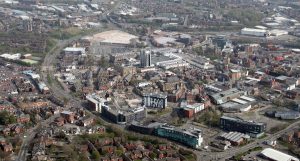
Image: Neil Mitchell/Shutterstock.com
If that’s not enough to tempt you then let’s throw in the fact it is a fairly recent Cathedral Town and there are a swathe of famous people who were born and bred here. Anyway, our mission is to persuade you to give Blackburn consideration as the base for your next visit to the area so let’s go back to the beginning and go from there. So without further ado here is the Five Minutes Spare quick guide, how old the town, what’s the history behind it, and what should you do when you get there? Let’s find out…
The Early Days of Blackburn
Being conveniently situated to the north and west of the Pennine Moors and edging on the Ribble Valley it is no big surprise to hear that his area of Lancashire has been occupied since the Bronze Age, with several archaeological digs confirming this. Fast forward a few thousand years and the Romans arrived and may have given it its name given that the name.
The name Blackburn is thought to be derived either from the black stream that ran through the area at one time or maybe a play on the nearby Blakewater River, since it is thought that the Romans had a military road which linked Manchester to Ribchester which a Temple dedicated to Serapis was erected on the road.
By the end of the 6th century, the Temple had become a church, recorded in 598 AD as the “church of Blagbourne” and this name stuck as it was recorded as Blachebourne in the Domesday Survey in 1086, when William the Conqueror decided to take stock of all the things he had stolen.
The population is not recorded however we think that it was probably quite large by then given that this either meant that there were no people there, or that there were too many people to count. In the case of Blackburn, it had two churches… and if there was nobody living there, there’d be no need for two churches. The land belonged to the Anglo-Norman noble Roger of Poitou at that time, having formerly belonged to Albert Grelley and Roger of Bully. Oddly, there was no record of how much money the land made the Lord, but it would have been a pretty penny, with two churches to tax.
Blackburn Gets A Market
During the days of the old English Kings, Blackburn was a Royal Manor which would have contained an estate. Excavations have revealed Bronze Age, Roman, and 11th-century workings, all in the same area. In 1101 the town got its first marketplace, having been granted a charter to hold a weekly market and an annual fair and a Medieval Parish Church was built in this century where the current Catherdal sits. The town was quite prosperous throughout the 12th & 13th Centuries as they had the nearest market for most villages in the area. Infact by the mid-1300s weaving was a growing part of the town helped by all the locally produced wool.
The cloth industry boomed in the following years with Flemish Weavers arriving in the 14th century and sharing their knowledge with the locals and Blackburn became famous for the blue and white checked fabric made here, known colloquially as the Blackburn Checks and the Blackburn Greys.
The weaving industry took over Blackburn’s economy by the mid 18th Century kept growing right up until the turn of the 20th. This also led to a population boom seeing the town grow from around 5000 inhabitants in 1701 to well in excess of 100,000 by the dawn of the 20th Century. No wonder the town was then known as the Weaving Capital of the world!
The Industrial Era in Blackburn
The Industrial Revolution was the moment of victory for this town. It saw the population grow from a partly 5,000 to greater than a hundred thousand people. This was helped in no small part by the Leeds Liverpool Canal which was completed in 1816 joining up the town with the other powerhouses of Yorkshire & Merseyside.
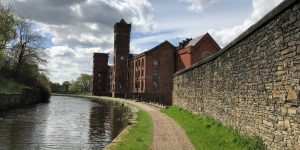
Image: Razvan13/Shutterstock.com
In 1801 there were 11,000 people in town, which might not seem big by today’s standards, but back then it was pretty massive. An improvement commission was set up in 1803 so that the streets could be lit and paved. Afterwards, the streets would be lit by gas, then later, by electricity. In 1807 the town got its own Brewery when what is today Thwaites originated – well all this cloth making is thirsty work This also led to steam-powered looms which needed fewer people to man them and sadly the result was civil unrest…
In April 1826 things turned ugly when the Lancashire Weavers Riots erupted. This was not confined to Blackburn tas loom destruction took place in the surrounding areas including in Chorley, Clitheroe, Bacup and Bury.
Blackburn was hit when a crowd marched from Accrington and donned hammers and scythes before marching on the towns spinning mills. They managed to break 212 of them – in 35 minutes! Such was the alarm that the army was called in to disperse the rioting and subsequently 42 people were tried and sentenced to death! Those were harsh times but before long the looms were repaired, the Luddites disbanded and the workers went back to being poor. Still, it was not all doom and gloom… that was to come later.
A Mayor & A Train!
By 1851 Blackburn had its own mayor, and the railway rolled into town in 1846, boosting the towns textiles industry massively. Between 1850 and 1890 dozens of new mills opened and as both spinning and weaving went into overdrive. The 1880s were busy with the first tram line opening in 1882 and then popular public space The Queen’s Park was opened in 1887. Next Blackburn Rovers joined the then fledgeling Football League in 1888 and moved to their current home stadium Ewood Park in 1890. Things were going great, however, in 1890 the Blackburn Chamber of Commerce are on record as being concerned that the town now only had one string to its bow and sadly this was to prove prophetic.
The Dawn of the 2oth Century
Early 20th century Blackburn was still dominated by the cotton industry but rising import tariffs on raw cotton were taking its toll and by 1904 unemployment was rife. Then if things were not gloomy enough WWI arrived and with it the suspension of trade with India. The town also suffered significant losses in the fighting with 3,117 men and women being recorded on the roll of those who made the ultimate sacrifice. The memorial book for the First World War in Blackburn was unveiled in 1929 at the old town hall, and you can also view the online version, here.
The end of the hostilities did little to lighten the economic gloom and in 1922 the Indian government sounded the death knell of Lancashire cotton-weaving by raised their taxes to 14%. That year it is estimated that 43,000 power looms lying unused and unemployment in the town was chronic.
How things changed in only 22 years. By the time of the general strike in 1926 around half of the mills had closed down, with 12,000 people thought to be unemployed, and things were set to get worse. Still, at least 1927 was a bit better as Matthew Brown & Co. Ltd relocated her from Preston and remained as brewers of their beer in the town until 1991.
1928 saw yet another slump in cotton production, and another huge strike as employers sought to slash wages to compensate for falling demand. By 1930, around 21,000 people in town were unemployed and slum living was rife and the global slump of the 193os did the rest. Things were bleak and sadly they were about to get worse thanks to Adolf Hitler embarking on his European tour!
WWII
Post War Blackburn
The cotton industry was pretty much devastated by WWII but enjoyed a short resurgence in the late 1940s and early 1950s as Britain began to rebuild. The number of workers involved in textiles production fell sharply although this was largely due to more efficient manufacturing. Despite this, the population remained relatively stable as it became popular with Indian and Pakistani immigrants coming to the UK post-war.
The last tram journey in the town took place in 1949 and this was pretty much synonymous of the declines to come. By 1958 the UK had become a net importer of textiles for the first time and in 1960 only 30 mills remained active in Blackburn. This decline slowly continued through the 1960s and 1970s to the extent that by 1976 the number of working looms in the town had declined by over 97% compared to 1907’s already depressed levels. It is fair to say that the days of Blackburn being a textiles town ended then. If you want to learn a bit more about the rise & fall of the Lancashire Textiles industry then this free Historic England publication is a good place to start.
Modern Blackburn
The recessions of the 1980s put the boot in further so to speak and it is fair to say that to this day it is a town looking for its new identity economically wise anyway. From an ascetic viewpoint though the town has never looked better as significant sums have been poured into regenerating the town centre, and it has large swathes of designated green belt making it a very pleasant place for those who love the wide outdoors.
Shopping is big in Blackburn and if you are looking for retail therapy, you will be spoiled for choice in its shopping malls. Thwaites Brewery still has its headquarters in the town and BEA Systems is a significant employer. However, the town is still heavily dependent on public sector employment and has suffered a bit under the austerity drive which the UK has endured in recent years.
Famous People from Blackburn
Blackburn is famous for more than just its historied football club. It is also home to a plethora of famous people both past and present. Who knows who you for you to might bump into at the supermarket! Anyway here are a few of Five Minutes Spare favourite famous folk out of Blackburn…
- Ian McShane, the famous actor who has graced the silver screens, first as Lovejoy, then later in Deadwood, Pirates of the Caribbean, and eventually in Kung fu Panda well his voice is in it anyway. He was Blackburn born but spent much of his early life in Manchester though.
- Rugby player Will Greenwood is from here.
- As is the X-Factor famous singer Grace Davies.
- Author Jo Cox was a Blackburn woman.
And there are so many more. In Wikipedia alone, there are 132 pages of famous faces out of Blackburn. They have a surprisingly large number of actors at their disposal. Who knew?
Fun & Not So Fun Facts About Blackburn
Every town has interesting bits. Whether they be morbid, curious, or hilarious, it never hurts to learn a few before you visit so you can roll them out at parties. With that in mind, here are some Five Minutes Spare facts about Blackburn:
- Between the newspaper and the Adelphi pub in town, you can still see a plaque dedicated to the All Hallows Spring Well that the Romans found and built their temple around, all the way back when.
- Witton Country Park stands at 480 acres… one of the largest of its kind in the country.
- Blackburn Rovers Football Club was actually formed by a group of Schoolboys in 1875. They played their first game that December drawing 1-1.
- A 3-year-old was murdered here in 1948, prompting the first-ever mass-fingerprinting exercise as the police sought the killer. Thanks to this they found the 22-year-old perpetrator of this heinous crime, who when confronted with the evidence confessed. He was subsequently hanged and the police promptly destroyed everyone else’s prints rather than start a database.
- There were Luddite riots here in 1826 when the peasants revolted as wanted to earn enough to eat. They destroyed some of the looms, getting the attention of the Army.
- The Sirloin cut of Beef is sort of attributed to the town – well actually the nearby village of Hoghton but its close enough. Anyway, the anecdote goes that James 1 was so impressed with the local beef served at Houghton Tower in 1617 that he knighted the beef – arise “Sir Loin”. Is it true? Who knows but is a mildly humorous way to end this section.
Things to do in Blackburn
Want to visit the best attractions in Blackburn during your at-home vacation this year? Check out the following things & places if you want to make the most of that holiday time…
Sport
If you are a sports fan then Blackburn has plenty to offer if you like Football or Ice Hockey anyway. Joking aside there is everything from Archery to Track & Field available, but as we are pushed for time (well it’s supposed to be a five-minute guide) we will focus on the main spectator and participation ones, starting with you guessed it the (once & future possibly) mighty Blackburn Rovers…
Blackburn Rovers FC
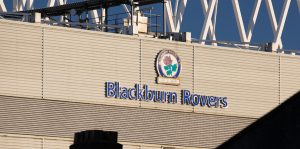
Image: Big Trev/Shutterstock.com
The Rovers or the Blue & Whites are the pride of the town sporting wise dating from 1875 and as we already mentioned was one of the 12 founder members of the English Football League.
Historic Sights and Landmarks
You should take the time to visit the nearby Hoghton Tower. Although not technically in the town proper, it is an excellent place to have a high tea and a wander around some historic buildings. It’s also an excellent live music venue and you should check out what’s on if you are in town.
Make sure you take the tour of Blackburn Cathedral, too. This fascinating religious location is still in use today. You can spy it from most places in town as it towers above all else with a magnificent steeple. Have a peek for yourself and see how you like it… remember to get plenty of shots for Instagram while you are there. There’s always St. Alban’s Roman Catholic Church too if you want somewhere less intense to worship.
Museums and Art Galleries
First of all, Blackburn museum and art gallery are both in one place. For not much cost, you can browse many of the best works of art in town, while simultaneously finding out about the history of the place. The only other place in town where you can learn about heritage or buy yourself a painting is the Bureau Centre for the Arts, which sounds ever-so-slightly suspicious.
Shopping and Retail
Blackburn has a fair few places you can go to shop. If you want a full shopping centre, The Mall Blackburn is a great starting point. Similarly, the Blackburn Bazaar has an array of all things Eastern. You have another option in shopping at the Blackburn Market, which has a less formal feel.
Outdoor Attractions
There are several outdoor attractions in and around town. Although the area might be landlocked, the top attraction of all in Burnbank is the local reservoir (Turton and Entwistle). This place is more than a water treatment plant, it’s a boating pond-come-picnic-area with a playpark thrown in for good measure. It’s also the place everyone goes to, to enjoy the beach when the sun goes down. Go along, have a splash, and play safe because reservoirs are dangerous.
Next up, Witton Country Park is another great spot to take the kids in Blackburn. This place has all you would expect from a nature walk and will entertain the family for hours. This location covers some 480 acres, incorporating meadow, forest, river, and field alike. There are bike tracks, and even a few sculptures scattered around for you to find. It’s one of the most beautiful places in the city.
The town has a fair few other parks, most of which were introduced during the height of park popularity, back in the Victorian era. One of the best known of all of them is the Corporation Park. It was designed by one William Henderson in 1857 and sits almost in the centre of town. It features the traditional mix of arched entranceways, sculptures, flower beds, and other important features – like fountains that haven’t worked in a hundred years… you know the type.
Theatre and Opera
You have a few different options for high-class entertainment in Blackburn which, let’s face it, was a weird place to put them. Visit the Blackburn Empire Theatre, which is impressive inside and not at all impressive on the outside. Alternatively, switch from community theatre to gigantic scale productions like those found in King George’s Hall… where they show productions fit for a king. Shame we don’t have one yet.
Sports and Recreation
Blackburn has a Planet Ice! This means that the teens have somewhere to hang out on the weekend – and that there are a few hockey groups you can join, too. You will find this place jam packed with visitors on a Saturday and Sunday. It’s just a really cool place to hang out.
Of course, the sport that made the town famous wasn’t hockey, but football. Blackburn Rovers are a Championship team who frequently place high in league tables. They are known throughout the entire world for their skill – and you can visit them at Ewood Park where you can take the tour or catch a game.
This being Britain you obviously have a choice of three different golf clubs. Visit Blackburn Golf Club, the Pleasington Golf Club, or slightly further north you can visit the Wilpshire Golf Club. All three are reportedly excellent and will fulfil your longing for golf.
Other Notable Attractions
There are actually so many good parts of this town that we couldn’t fit in all the attractions. We did try though, so we added some of the other best bits of Blackburn for your viewing leisure:
- The Three B’s Brewery brings you a delightful adults-only experience. Take the tour or just drink the beer… you’re welcome to do both.
- Take a boat tour or enjoy fun in the water with the Canary Divers group.
- Visit Chapels Spa for the relaxation experience of a lifetime.
Where to Eat, Drink, and Party in Blackburn?
They say that you will find the best cocktails in town at Mushies Coffee and Cocktails. This nice café changes when the sun goes down… but it makes for a great all day stopping point. Shhbar is another local favourite as a place to get started before you go on a full-out rager. If you fancy a change of scenery, enjoy a pint at the Feilden’s Arms or enjoy the Blues Bar at Ewood Park in Blackburn.
How to Get to Blackburn?
As ever, we have told you everything you need to know about Blackburn except from how you get there. We have all the answers you need, but don’t call us if you get lost.
By road
Head north of London until you hit the M6, or south from anywhere else.
By Rail
The main station is Blackburn Railway Station, although there are others.
By Air
Your nearest airport is Manchester Airport.
By Sea
Unfortunately, you are landlocked if you are in Blackburn.
Still Stuck for Staycation Ideas?
No matter the year, dates, or destination, you can find all you need to know about your potential holiday hotspot, through Five Minutes Spare. Chose what you want to do on staycation before you even leave your house. Better yet, pick up a new hobby in case we live to see another lockdown. If 2020 taught us anything, it was that you can never have enough hobbies.
